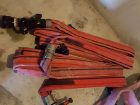
Features
Structural
Training
Back to Basics: December 2016
We have been exploring the topic of standpipe-equipped buildings and highrise operations. In November, we looked at the equipment needed to conduct standpipe operations, and I mentioned that firefighters can carry only so much, which leads to the next topic: how many firefighters are needed for this type of operation?
November 22, 2016
By
Mark van
As mentioned in part 1 in August, highrise or standpipe-equipped operations are manpower intensive, requiring more work than structure fires in one- or two-storey buildings, because of the need to travel to the fire floor or the floor below it, and also carry equipment (see photo 1).
The number of firefighters required to execute standpipe operations depends on the situation: large metro fire departments such as Toronto Fire Services or Vancouver Fire & Rescue Services deal with standpipe operations differently than smaller departments such as the St. Thomas Fire Department in Ontario or the Grande Prairie Fire Department in Alberta. Departments respond to calls that require standpipe operations based upon how many firefighters are available.
A study conducted by the National Institute of Standards and Technology (NIST) in the Washington D.C. area in 2013, entitled the Report on High-Rise Fireground Field Experiments quantified data based upon three-, four-, five- and six-person crew deployments. The study was based on 48 field experiments using a 13-storey vacant commercial building.
The study, which involved a fire on the tenth floor, determined that the bigger the crew size, the better the outcome in terms of time to complete tasks and exposure to increased fire conditions.
Overall time to task completion
- Three-person crews took almost one hour to complete their first response.
- Six-person crews took just under 40 minutes to complete their first response.
- The four-person crew took about 50 minutes, and the five-person crew took about 42 minutes.
- Advance attack line – 2 ½-inch (65 millimetre) handline from standpipe to fire location:
- Three-person crew took one minute and 43 seconds longer than a four-person crew;
- Three-person crew took two minutes and 47 seconds longer than a five-person crew;
- Three-person crew took four minutes and 28 seconds longer than a six-person crew.
- Advance second line – 2 ½-inch (65mm) handline from standpipe to fire location:
- Three-person crew took four minutes and four seconds longer than a five-person crew;
- Four-person crew took two minutes and 43 seconds longer than a five-person crew;
- Three-person crew took five minutes and 38 seconds longer than a six-person crew.
Fire out, first and second attack line in place:
- There was a two minute and 14 second difference between the three- and four-person crews;
- There was an additional one minute and 15 second difference between the four- and five-person crews;
- The five-person crew extinguished the fire three minutes and 29 seconds faster than the three-person crews;
- There was a seven minute and two second difference between the three and six person crews.
- Search and rescue, tenth floor:
- The four-person crew started the search one minute and 23 seconds faster than the three-person crew – and completed it in 11 minutes and 21 seconds faster;
- The five-person crew started the search one minute and four seconds faster than the four-person crew, and two minutes and 27 seconds faster than the three-person crew;
- The five-person team finished the search-and-rescue operation 13 minutes and 34 seconds faster than the four-person crew, and 24 minutes and 55 seconds faster than the three-person crew;
- The six-person crew started the search-and-rescue operation one minute and 19 seconds faster than the five-person crew, and completed it two minutes and 57 seconds faster than the five-person crew;
- The six-person crew started the search three minutes and 46 seconds faster than the three-person crew, and finished 27 minutes and 51 seconds faster than the three-person crew.
- Victim No. 1 rescued on the tenth floor:
- The five-person crew located the victim 25 minutes and 19 seconds faster than the three-person crew and 12 minutes and seven seconds faster than the four-person crew;
- The six-person crew located the victim 28 minutes and 33 seconds faster than the three-person crew, 15 minutes and 21 seconds faster than the four-person crew, and three minutes and 14 seconds faster than the five-person crew;
- The four-person crew rescued the victim 13 minutes and 11 seconds faster than the three-person crew;
- The five-person crew rescued the victim 11 minutes and 39 seconds faster than the four-person crew;
- The six-person crew rescued the victim 14 minutes and 58 seconds faster than the three person crew.
The NIST study shows that six-person crews are more efficient and effective for highrise operations than three-person crews. For the larger, city fire departments, this is not a problem; they can join two responding crews together to form a six-person crew. But can smaller departments do this? Do they have enough responding personnel to form a four-person or a five-person or six-person crew? Or must they operate with three-person crews?
Small departments can use two approaches to ensure the necessary manpower: mutual- or automatic-aid agreements, and an automatic call-back system of off-duty personnel. A combination of these two systems works best: both systems guarantee that firefighters will respond.
Mark van der Feyst has been in the fire service since 1999 and is a full-time firefighter in Ontario. Mark teaches in Canada, the United States and India and is a local-level suppression instructor for the Pennsylvania State Fire Academy and an instructor for the Justice Institute of BC. He is also the lead author of Residential Fire Rescue. Email Mark at Mark@FireStarTraining.com
Print this page


